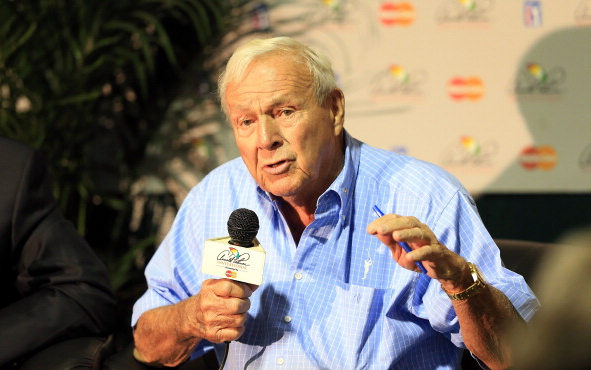
ORLANDO, FLA. — A funny thing happened on the way the Arnold Palmer Invitational here Thursday.
A LIV Golf tournament broke out.
Sixty-nine players, an absurdly oversized $20 million purse, a $4 million first prize and no cut*. (*All right, there is a cut at Bay Hill but just barely — the low 50 players and ties PLUS any player within ten shots of the lead, which could potentially be everyone in this exclusive 69-player field.)
While the PGA Tour keeps trying to stamp LIV out of existence, it keeps slowly becoming more like LIV. Doesn’t anyone at the Death Star in Ponte Vedra own a mirror?

The late Arnold Palmer would be irate… in my humble opinion. This is not the PGA Tour he helped invent, launch and propel to great heights.
Here’s something even more stupidly stupid (sorry, that redundancy was necessary to make a key point): The API winner gets 700 FedEx Cup points.
Normally, no one would care about those stupidly stupid FedEx Cup points. But you possibly should care. The winner of the Masters Tournament and professional golf’s other major championships gets 750 points, as does The Players, which is no longer on a level with majors since it will be missing LIV defectors such as reigning PGA Championship winner Brooks Koepka, reigning Masters champion Jon Rahm and recent major champs Cameron Smith, Dustin Johnson and Bryson DeChambeau. (The majors can still invite those guys. The Players can’t/won’t.)
Somehow, a half-field event without a cut is deemed nearly as important as a major championship? Where are we, North Korea? This could only happen here at LIV Golf — I mean, the PGA Tour.

It will take a win and a top-10 finish in a regular event to equal a win in a Signature Event. Is it more difficult to win against a smaller field of higher-ranked players or against a full field of all players? I believe it’s the latter and this year’s list of long-shot winners isn’t a negative — it proves the quality of the tour’s depth.
The API is a designated Signature Event, the fourth one this year. These tournaments used to be known as Elevated Events but that irony was probably too much even for PGA Tour execs.
The only thing elevated is our blood pressure about how every player in these small fields gets world ranking points while LIV Golf players get none despite the many similarities. Not that I’m suggesting the LIV players should get points. I’m not. Perhaps no tournament with fewer than 78 players should get ranking points. I just made that number up. It is every bit as arbitrary as the FedEx Cup points allotment.
So, losing “Elevated” was a smart marketing name change. But do you really want your tour’s “Signature” to be keeping players out of select events?
Palmer always told young golfers to make sure their autographs were legible, as he did. In this case, the PGA Tour’s Signature is loud, clear and all too legible — it’s about funneling big money to the top players. The message to the Tour’s rank-and-file is: quit cluttering up our tournaments and keeping our designated “stars” from winning and piling up more millions.

I can’t find the exact quote from Palmer, so I’ll paraphrase. He said something like when he and Jack Nicklaus helped the PGA Tour break away from the PGA of America (the club professionals) in the 1960s that they wanted to create a tour where every player had a fair chance.
The PGA Tour has long benefitted from being one of the few sports where meritocracy rules. You won only what you earned.
The playing field has been tilted now in direct response to LIV Golf’s rival league.
By limiting fields in eight Signature Events, rank-and-file tour players lost playing opportunities. The common response to complaints about that is, “Just play better.” The rank-and-file can’t play better if they can’t get in the field.
The opportunity crush has been felt by the secondary Korn Ferry Tour. Its top players who earned PGA Tour privileges this season, have gotten only a few starts so far. That’s not the kind of fairness Palmer and Nicklaus envisioned.
Somehow, the PGA Tour didn’t learn a lesson from its now-defunct World Golf Championship series. Those, too, were limited-field events of around 70 to 75 players. Those smaller fields often led to less drama on the leaderboards (unless Tiger Woods won) and a lack of spectator energy on the course. Plus, those fields teed off on the 1st and 10th tees and golf for the day was over in five hours or less.

In addition, those star-studded fields drew top players away from the tour’s other 40-plus stops. The player who might have had New Orleans or John Deere or Valspar on his schedule, for instance, dropped them to play in the richer WGC events. The tour effectively undercut its own tournaments and hurt its overall product for its own profit.
The WGCs are gone now and no one misses them. But here we are again, wondering, “what fresh/familiar hell is this?”
It is easy to see the Tour’s footprint shrinking at this rate from 40-plus events to 25-plus so-called “big events.” Less isn’t more. The history of golf shows that less is always less. And isn’t the tour’s mandate to provide as many decent playing opportunities for its members as possible?
Here are a couple of reality checks:
One: The Saudis and LIV can outspend the Tour by a billion a year for, oh, about the next 50 years without breaking a sweat. That framework agreement seems like it’s dead in the water now and the flip side of that could be, this means war. It’s a money war that only one side can win. And it’s not the Tour.

Two: Pro golfers don’t make nearly as much as players in other American pro sports. Guess what? Golf, except when Tiger Woods was in his prime, is a niche sport. It is still a niche sport. It doesn’t get squat for TV ratings compared to the NFL, Major League Baseball or even the National Basketball Association. Pro golf has thrived in magazines and on TV because of demographics. It delivers the wealthy over-40 male that advertisers want (or used to want) to reach. Pro golf isn’t nearly as popular as the big three sports. Based on that, golfers should be paid considerably less than Shohei Ohtani and DeShaun Watson and Giannis Antetokounmpo. Who are we kidding?
Three: Golf doesn’t have a Super Bowl or a World Series. It’s got the Masters, which is over in mid-April.
Four: As superstars go, the PGA Tour has a current shortage, unlike the other pro team sports. I mean real, page one Superstars. Tiger Woods still moves the needle, the cliché says, more than anyone else in golf. And his body is so breakable that he has trouble finishing a 72-hole event. Next best right now? Rory McIlroy? He is popular, even more so in Europe, but he honestly doesn’t move the needle much. Scottie Scheffler? Jordan Spieth? Justin Thomas? Get serious. The narrative of golf is always better with a top dog, or a Woods and Phil Mickelson, but rarely is lucky enough to have two semi-dominant players at once. Reducing the field size may be one way to try to legislate the big names into more victories but even if that works, which it hasn’t, it will hurt the future stars who would have been created. Which has always been a tour strength.

“It’s a dog-eat-dog world,” barfly Norm once observed on the old-time “Cheers” sitcom, “and I’m wearing MilkBone underwear.” The rich are getting richer on the PGA Tour and often at the expense of the rank-and-file.
Last year, tour player Nate Lashley wondered aloud whether the Player Impact Program, in which the tour bestowed $100 million on the top 20 players in a murky social media ranking system, was a proper use of the tour’s $100 million.
It was a valid question. Yes, the players with starpower bring more to the tour than the rank-and-file. But they already get the rewards of that through endorsements, don’t they? That $100 million was nothing more than a bribe to keep them from bolting to LIV. It didn’t work with Rahm and Tyrrell Hatton.
The PGA Tour already has a curious pension system that isn’t capped, allowing the players who earned the most money during their careers to reap the biggest pensions. So, the guys who raked in $400 million or more get super-large pensions? But why do they need big pensions? The guys who need the pensions more are they guys who didn’t score millions and didn’t have big endorsement deals. Not to be crass but what does Jordan Spieth, say, need with another $20 million that he’s never going to spend? Pensions were designed to help pensioners who need help.
During the Deane Beman era as PGA Tour Commissioner, the tour was run for the rank-and-file guy, which was what Beman was. Now the tables are turned, because of LIV. In order to acquiesce to the top players and keep them from departing for LIV Golf’s astounding bounties, the Tour is run for the benefit of the stars. Worse, it is being run now BY the stars.

A new deal with PGA Tour Enterprises, an investment of some $3 billion plus, has the first $1.5 billion earmarked for players, some current and some former, but the sums will decidedly favor the most successful players. With Tour Players now having more say on the PGA Tour Policy Board, this is the kind of thing you can expect.
Why? Because the top players have taken control. The rabbits are guarding the lettuce. They are inevitably going to take more of the lettuce for themselves.
I don’t believe the fair-minded Palmer would like the changes made to the 2024 edition of the API or the tour’s other star-driven moves. I don’t think the makes this tournament better or more exciting. Just the opposite. But if it ends with a close finish, maybe a playoff between McIlroy and Scheffler or Thomas, it’ll be considered a success.
Level playing field? Meritocracy? Those core values have never been less true in the history of the PGA Tour.
It’s a shame to have to admit that at Bay Hill, the home of Arnold Palmer.






































